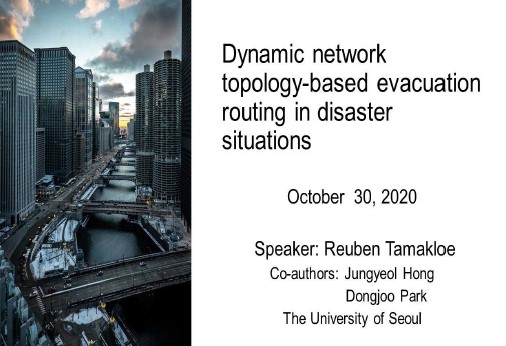42. Dynamic network topology-based evacuation routing in disaster situ…
구두 Session 2, 교통운영, 30(금) 13:10-14:40, 볼룸3, pp.202-207
Dynamic network topology-based evacuation routing in disaster situations (재해 및 재난에 대비한 동적 네트워크 토폴로지 기반 대피경로 알고리즘) / Reuben Tamakloe(University of Seoul), Jungyeol Hong(University of Seoul), Dongjoo Park(University of Seoul)
During evacuation routing, disaster managers seek to, among others, minimize the tendency of confusion and congestion occurring on the roadways. This is most important during the evacuation process as panic-stricken evacuees are likely to indulge in activities that could further worsen their chance of evacuating quickly. Although this challenge is central to evacuation planning research, analysts have mostly employed static link impedance factors in determining evacuation routes. This approach guarantees that the shortest paths are selected for vehicle evacuations; nevertheless, it fails to appropriately capture the dynamic spatio-temporal and structural changes within the network. As transport networks are highly characterized by frequent changes, especially during disaster situations, it is imperative to capture these network changes to guarantee the safety and smooth flow of evacuees as they are routed within the network to safe shelters. Against this backdrop, this study employs a link betweenness centrality measure to develop a disaster evacuation simulation algorithm that dynamically identifies central evacuation paths based on the structure and dynamic spatio-temporal traffic exposure on links within the network. Using the Yeouido Island transport network as a case study, we compared our algorithm to the static shortest path evacuation algorithm mostly applied in evacuation routing studies. From the results, it was identified that employing the proposed dynamic network centrality-based algorithm guarantees that evacuees travel with higher speeds on low congested routes. We also identified that the shortest path algorithm suggests routes that are shorter compared to our proposed algorithm; however, evacuees using such paths would be subjected to high levels of congestion, which has the tendency to cause evacuees to either partake in risky behaviors or fail to follow prescribed evacuation plans. The results from this experimental study offer pertinent insights into factors that can be employed by evacuation planners for the development of appropriate evacuation plans that would guarantee reduced casualties during evacuation routing.
좌장 : 이기영, 김인희
















